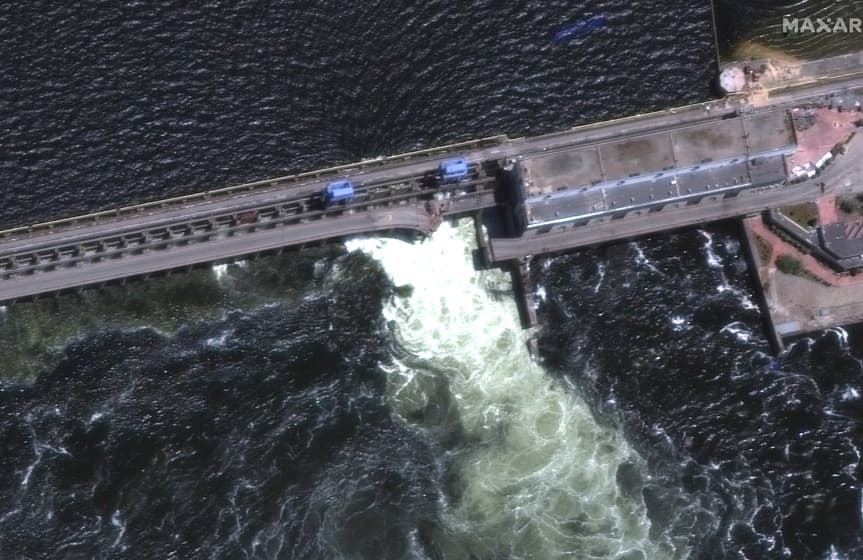Dam Busting: Russia Accused of Using Water as a Weapon, Thwarting Ukrainian Counter-Offensive in Kherson Region
‘From a tactical point of view,’ Kyiv ‘can forget about an offensive in Kherson,’ one Russian observer says after the destruction of a major dam across ‘Ukraine’s Mississippi.’

Russia, by blowing up a major river dam across the Dnipro today, as Ukrainian and Western officials contend, has unleashed millions of gallons of water to block a Ukrainian cross-river offensive, turning 100 miles of front line into swamp.
The early morning explosion at Kakhovka dam took place hours after Ukrainian troops took several river islands in an effort to establish a beachhead on the east bank of the Dnipro.
Instead, a water surge of up to 20 feet rolled across islands and lowlands, forcing the evacuation of soldiers and villagers on both sides of a river that often is called Ukraine’s Mississippi.
It is unclear if Russian troops on the eastern bank of the Dnipro had time to evacuate ahead of the water surge. In 1941, at the start of World War II, retreating Red Army soldiers partially blew up the Zaporizhia dam, then the only dam across the Dnipro.
That flood surge killed up to 100,000 civilians downriver, as well as dozens of Soviet soldiers and officers fleeing across the dam at the time of the explosion.
Today, Russian soldiers entrenched downriver from Kherson, on the Kinburn Spit, may soon find their positions flooded — or the strategic peninsula turned into an island, a Ukrainian military spokeswoman, Natalia Humeniuk, told RFE/RL today. This would “complicate the enemy’s logistics,” she said.
Yet, in general, the dam breach and flooding take the pressure off the western sector of Russia’s 600-mile front line. Egor Guzenko, a Russian volunteer fighter and blogger, reacted to the dam breach today: “From a tactical point of view, [Ukraine] can forget about an offensive in Kherson.”
If Russia is behind the attack, it’s a violation of the Geneva Conventions, which explicitly ban targeting dams in war because of the danger to civilians. Drone videos of Kherson, the regional capital, show water covering streets and flooding Glory Park, which memorializes Soviet soldiers who died crossing the Dnipro in fighting against Nazi Germany in World War II.
“Russian terrorists. The destruction of the Kakhovka hydroelectric power plant dam only confirms for the whole world that they must be expelled from every corner of Ukrainian land,” President Zelensky tweeted today from Kyiv, 400 miles to the north. “The terrorists will not be able to stop Ukraine with water, missiles or anything else.”
“The U.S. government has intelligence that is leaning toward Russia as the culprit of the attack, according to two U.S. officials and one Western official,” NBC News reported Tuesday afternoon. A White House spokesman, John Kirby, told reporters, “We cannot say conclusively what happened.”
Separately, Chancellor Scholz said the dam explosion “fits with the way Putin is waging this war.” NATO’s secretary-general, Jens Stoltenberg, said the blast “exposes the brutality of Russia.” The U.K. foreign secretary, James Cleverly, tweeted: “The destruction of Kakhovka dam is an abhorrent act. Intentionally attacking exclusively civilian infrastructure is a war crime.”
From Russia, the Kremlin spokesman, Dmitry Peskov, “categorically” denied any involvement in the destruction of the dam, blaming the breach on “deliberate sabotage by the Ukrainian side.” He said: “Apparently, this sabotage is also connected with the fact that having started large-scale offensive actions two days ago, now the Ukrainian armed forces are not achieving their goals.”
However, Russian soldiers have treated the dam as a military asset since seizing it 15 months ago. Last November, as Ukrainian soldiers approached the river’s west bank, Russian water engineers lowered water levels in Kakhovka reservoir to the lowest in 30 years — a clear attempt to slow the Ukrainian advance downriver.
Since then, sluice gates were closed, boosting reservoir water levels to 200 million square feet, the highest in 30 years. As water slopped over the top of the dam last month, it became clear the Russians were preparing to use water as a weapon of war.
In fighting last fall, Ukrainian artillery shelled the two-mile-long earthen dam in an ultimately successful effort to cut road and rail lines running across its top. At the time, Mr. Zelensky publicly warned that the Russian military had mined the generating room of the Soviet-era dam. It was an explosion in this turbine room that breached the 98-foot-high dam.
Today, Mr. Zelensky told an international forum: “It is physically impossible to blow it up somehow from the outside — with shelling. It was mined. It was mined by the Russian occupiers and blown up by them.”
At the northern end of the 150-mile-long Kakhovka Reservoir, the Zaporizhzha nuclear power plant, the largest in Europe, depends on reservoir water for its cooling systems. But, with five of the six reactors shut down and the water level high in the plant’s cooling pond, the International Atomic Energy Agency chief, Rafael Gossi, said today: “There’s no immediate risk to the safety of the plant.”
Mr. Grossi, who plans to visit the complex next week, added that because “the reactors have been shut down for many months it is estimated that this pond will be sufficient to provide water for cooling for some months.” Russia has controlled the power plant since March 4, 2022.
The dam breach hurts Russia, too. One of six hydroelectric dams on the Dnipro, Khakovka supplied electricity to an estimated 2 million people in southeastern Ukraine under Russian occupation. The only Dnipro dam controlled by Russia, Khakovka was cut off from Ukraine’s power grid last year.
Soon after Russian forces seized the dam on February 24, 2022, they restored drinking and irrigation water through a communist-era canal to Crimea. This parched peninsula was cut off from Ukrainian water supplied after its annexation by Russia in 2014.

